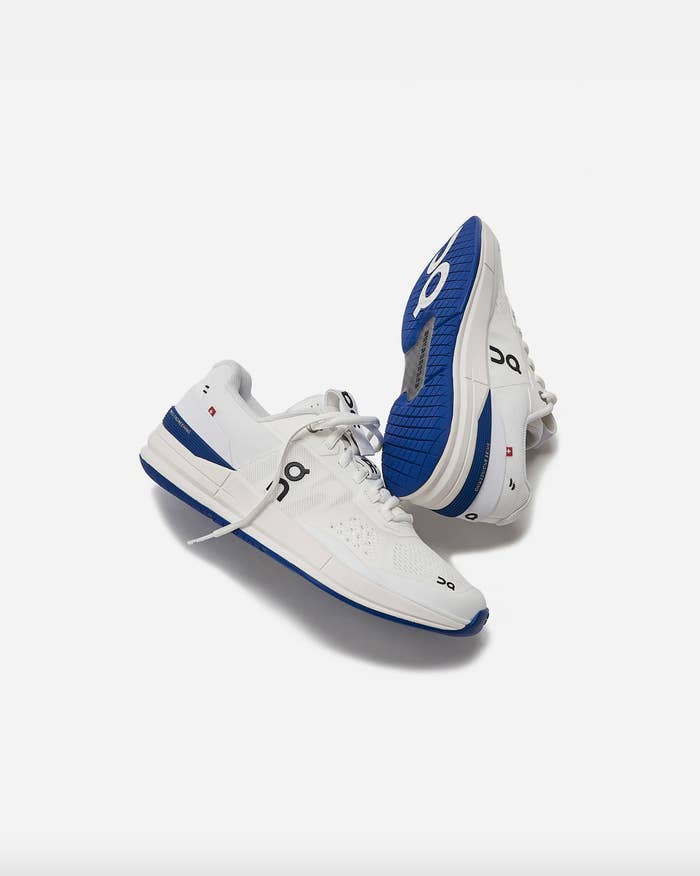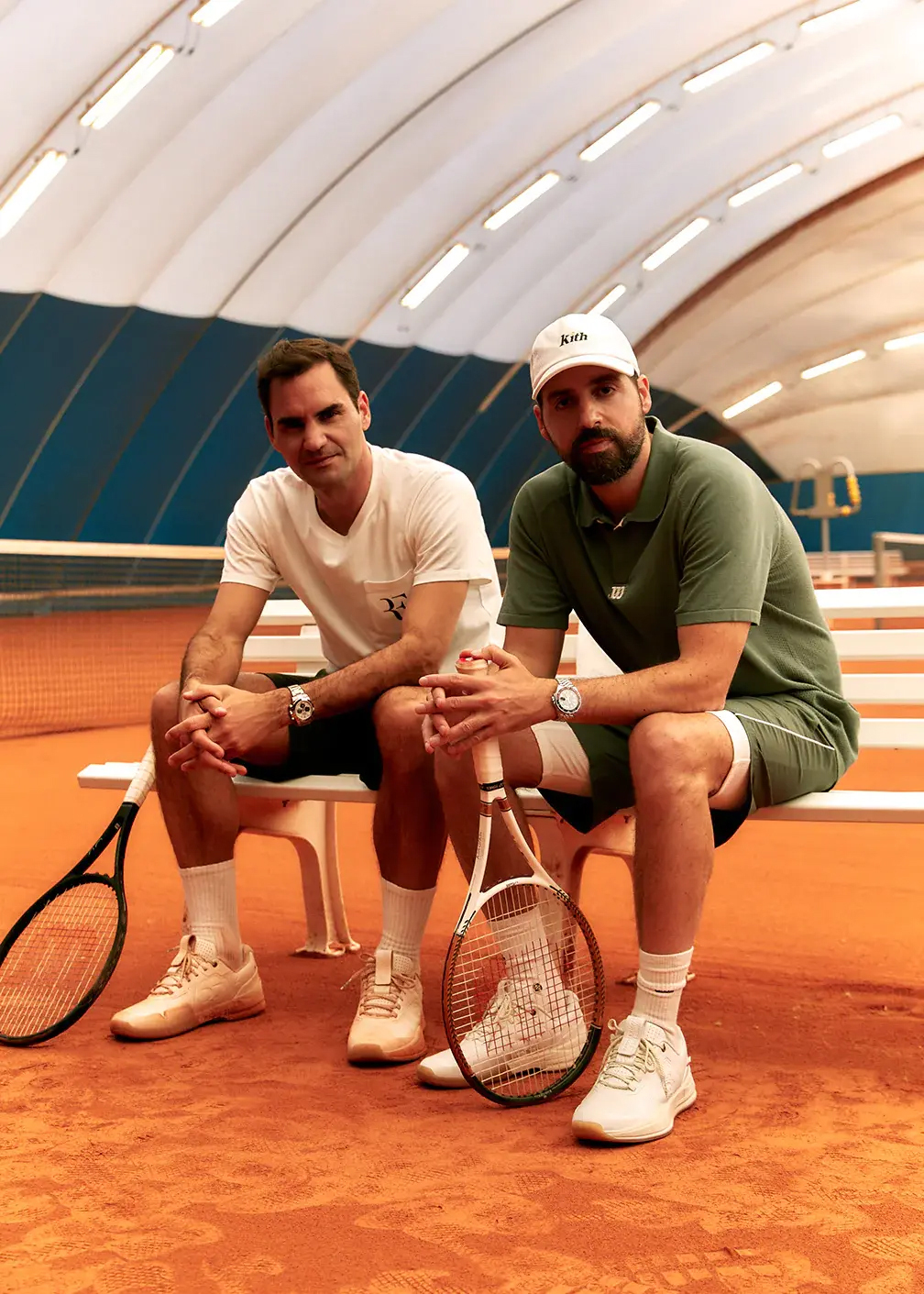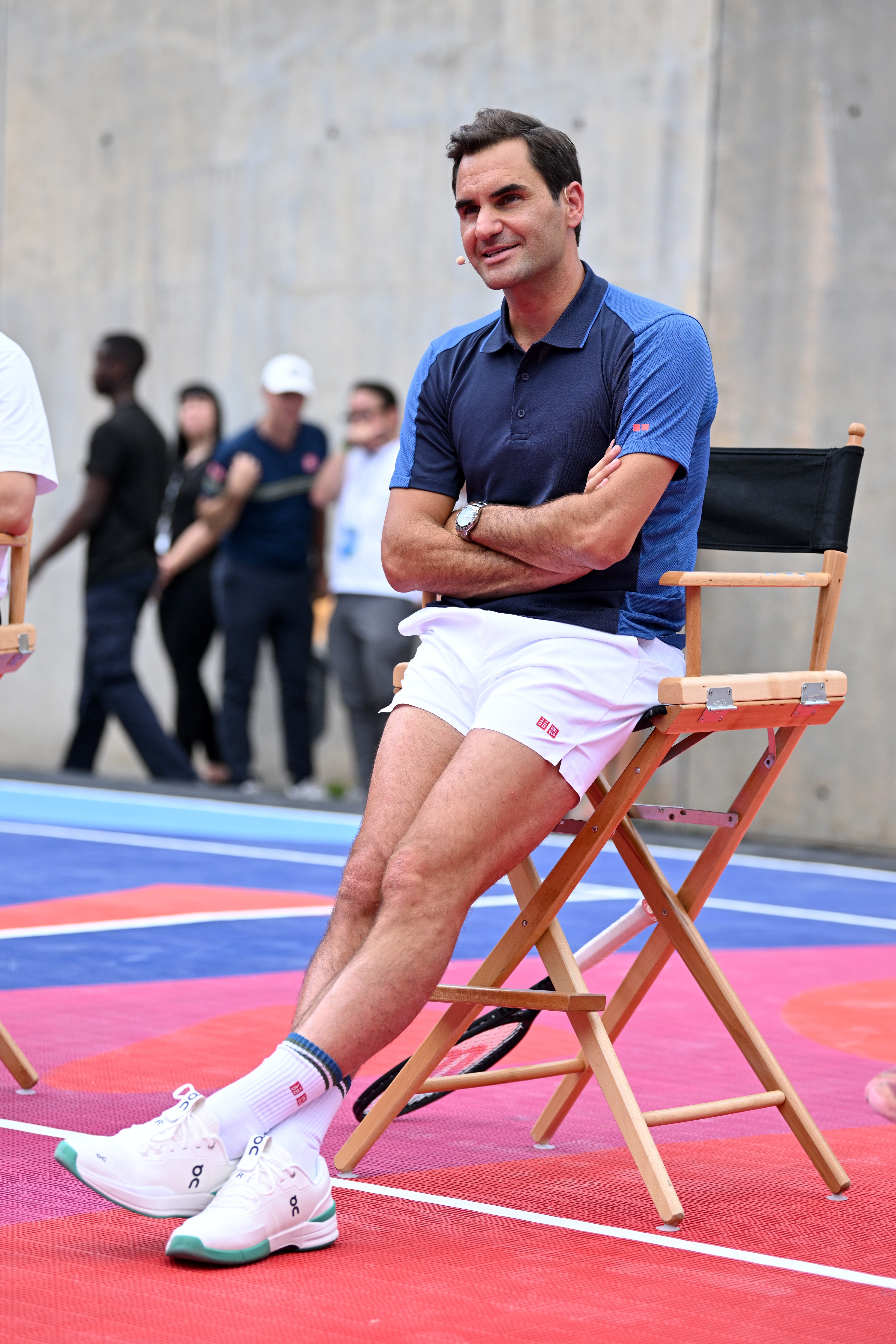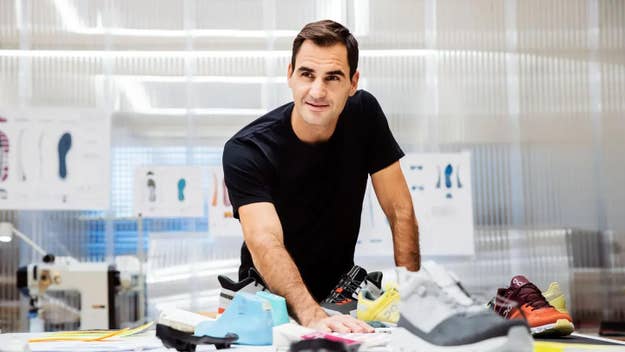
It’s a summer afternoon at Fort Greene Park in Brooklyn and there are over 100 people wearing On sneakers. That might sound like any day in New York City, but the crowd is there for arguably the best tennis player ever, Roger Federer. The tennis courts are packed and people are waiting in line to see if the sneakers live up to their namesake’s legacy.
Federer, who left Nike in 2018 and joined On as a three percent owner in 2019, is in town to promote his sneakers, which everyone is getting to test on the public tennis courts, and to take in the scenes of the US Open.
A few years back, fans would have flocked to get a look at Federer in person, but their desire to try out On sneakers might not have been the same. All of that’s changed, though. The city is flooded with sneakers from the Swiss brand, and they’re slowly creeping into the sneakerhead space.
“We started On in 2010 and now 60 percent of our business is in the U.S.,” says the brand’s co-CEO Marc Maurer, who has served in the position since 2021. “We also spend a lot of time here to understand what the U.S. consumer wants. We have a big part of our team located in the U.S. Product creation is starting to happen partially out of the U.S.”
Federer has two signature sneakers with On: The Roger, which is a lifestyle sneaker, and The Roger Pro, which is a performance tennis shoe and a design that Federer was thoroughly involved in.
The sneakers have gained steam in the sneakerhead market, in part to On’s rising popularity, but also thanks to a collaboration with Kith and Ronnie Fieg, called RF Squared from 2022. The collection included both the performance and lifestyle version of Feder’s sneakers, which were hand-rubbed with clay by both Federer and Fieg. Kith was the exclusive retailer of the blue and white The Roger Pros.
During his New York trip, Federer made an appearance at the recently opened On store in Williamsburg and took on the role of sneakers salesman. The On store in SoHo has become notorious for having a line outside the shop on a daily basis, which created a real need to open a second location in the city.
“That's why we opened the second store now in Brooklyn,” says Maurer of the lines in SoHo. “And so in Williamsburg, we hope you can have two lines and each line gets a bit smaller.”
Federer becoming part of On made him much more than Nike was ever going to pay him. Per a 2022 report by Quartz, when On went public in 2021, Federer’s 3 percent ownership was worth $180 million. It’s this opportunity that’s given him a new perspective on how athletes should or shouldn’t approach deals, although he admits that not all athletes are in a space where they can accept long-term money over short-term financial success.
“Not thinking as an athlete is not easy,” the tennis icon says.
Below is the full conversation with Federer, where we spoke about his ownership in On, the brand growing in the U.S., and the comparisons between him and Michael Jordan.
You’re signed to On now and you’re a three percent owner of the company. The brand has blown up massively since you signed; did you expect that to happen?No, I mean, my expectations were just, I want to help a Swiss brand and let's create something cool. Let's do something different than just a classic ambassador collaboration or partnership. Let's make it more meaningful. And On was feeling the same way, because On was coming up. I think we hit at the right time. The stars aligned and all that and I didn't think of IPO and all that stuff and the growth like this. I just thought, “Well, let's create cool stuff together and see where the journey takes us.”

Were you nervous at all? Because when you left Nike, you signed to Uniqlo and people were maybe just speculating where your career was going to go sponsorship-wise. And then landing at On, an upcoming brand.
Uniqlo, for me, was a blessing and a great partnership; it started with a lot of trust right away. And them not having shoes allowed me to just explore a discussion with On. In Switzerland, everybody was walking around in On already; they had over 40 percent market share. My wife started wearing them and I'm like, “What's going on? Who are these people? And they're from Zurich? Why don't we meet up and see.”
And then I said, “Well, why don't I maybe start working on a tennis shoe?” If ever something comes out of it, we got to, let's start. And if nothing comes out of it, I'm happy that they have my know-how and hopefully I can give some energy into a cool Swiss brand and I wish them only the best.
That's why I think I ended up being able to play on my comeback with On shoes, because we had started before we even had an agreement, because we started working on something together. And that was fantastic.
You have The Roger, which is more of a lifestyle shoe. You have The Roger Pro, which is the on-court tennis shoe. How much feedback did you give to creating that performance shoe?
The performance shoe a lot, like I said, we started before we even had a deal. I remember they came to Australia with the first ones from the factory and they're like, “Please, it's just the beginning. It's so bad, but we want to still show you.” And then I looked at like, “Yeah, it’s very bulky. I don't think it is going to work. We still have a ways to go.” I was a starting point.
I remember we went to practice next time and Olivier Bernard was there, the founder, and he was next to me, he goes, “Tell me everything you feel in the shoe.” I'm like,”We still need more outsole. We need it thicker. I'm too close to the ground. It feels like my big toe was almost on the ground.” So we did a lot of testing. I gave him a lot of input and I wanted to really make sure it was extremely stable on the side. So nobody would twist their ankles in the Roger Pro.
Now with the Roger Pro 2, that Ben Shelton is playing in the US Open, we upgraded it. It was like a facelift of the first one, but I'm really happy that the first one has been as good as it has been. It looks good, too. It's sleek and I'm very happy with it.
I made a joke about the dirt here being like playing on clay, but when you launched the shoes, you had that project with another RF, Ronnie Fieg.
We covered them in clay.

Did you do it yourself?
I did like probably 100 pairs or so. We rubbed them personally and then signed them all as well. That was a cool collab. I really enjoyed working with Ronnie and his team. I feel like also he enjoyed it, you know, the whole creative director thing behind the shots and we were sitting there trying to come up with a great commercial, you know, and how we would end it. It was during COVID times; I was in the French Open and we had a conference call from there as well. It's been great, though, especially also not being just on the court but off the court as well. It's always been very important for me to do that crossover.
That's also why I think when we launched the first one, it was a lifestyle sneaker. People were like, “We want the tennis shoe.” I'm like, “No, no, we'll get to it, you know, but we still needed a bit more time on the competitive shoe.”
I think at the time you were at Nike, the sneaker industry was dominated by Nike and now we're in a space where there's a bunch of other brands. On’s one of the biggest ones. Everyone has a smaller piece of the pie getting broken up. Why are these brands able to pull away from the traditional sportswear brands?
I mean, I think sometimes some people are happy to try something different as well and then I think it's timing, a lot of life has got to do with timing. I think maybe COVID has also had a big impact on us and the way we wear clothes, what shoes we want to wear. It's gone very much into the comfort: clothing, comfort shoes, running became really, really big through COVID as well. And I think maybe right at that point, On had great running sneakers, very comfortable shoes. And once you buy an On shoe, you want another pair. You get to know the brand and once you know the brand, I feel like it's a very forward thinking, very new, very hip brand. And I think it crosses a lot of the boxes for a lot of people, and I still think the image is totally different in certain places. Like China is different to North America to maybe how Spain sees it, how maybe Brazil sees it. I think it's very interesting to see with every launch, like the Cloudmonster or the Swift or the tennis shoe, how it changes, you know. The landscape is still being painted and it's only the beginning.

I think it's interesting, too, because you mentioned in Switzerland that the brand is everywhere. I think you talk about the perception of it in New York City. You see the brand everywhere on the streets, but it was almost a perception that it was European tourists coming with their shoes.
That's probably what happened. They came over on their flight and had their shoes on type thing. Yes, I agree with you. That's been interesting, because in Switzerland, from my granny to the little kids are wearing it. Some people are like, “No, I need some cool stuff. I can't have my granny wear the same shoes as me.” The brand is still so young, some compared On to Nike, which is not fair, or Adidas. They’ve been in the business for so, so long. But now you really see when you go into an On store how much wider the collections are of the shoes. You got the Nova, you got the Cloud Go, etc. They keep on adding to the wider spectrum of shoes. I think now you're starting to have shoes for everyone. Whereas in the beginning it was pretty narrow.
Have you seen in New York that there's a line outside the store?
No, I have not seen that.
I guess on a daily basis people are just lining up.
That's sick. That's really cool. I'm happy to hear that. I mean, I'm sorry that they have to wait, but that's good news. That was today at, at the one in Brooklyn, Williamsburg. I was actually selling some sneakers, like some customers walked in and I was like, “Ok, let me help you out.”
Did you lace them up?
I did not lace them up for them, but I got them out of the shelf, brought it to them, and gave them some feedback service and I sold my first couple of shoes.
There was the Air movie that came out recently with the story of Michael Jordan signing to Nike. And the most important thing was his mother wanting him to get a percentage of the sales of the brand. With you getting the 3 percent of On, do you think it puts you in that rare piece of owning a part of the company?
I think Jordan's story is very unique. Every story is unique and sometimes you have certain brands, they hit rock bottom before they thrive and all that stuff. So I feel his story is unique and I do think like my situation maybe shows other athletes what can be done, that investing in a young company or getting a piece of the company is very different. Not thinking, “What is going to be my paycheck at the end of the month for the year?”
But maybe the paycheck in 10 years. Not thinking as an athlete is not easy, and I know you need to be in a secure place and very confident to have the right people advising you and your parents as well, too, like with Jordan, to give you that confidence to maybe go for that instead. It's not simple. But look, my relationship now with On is great. It's super close because when you are a shareholder owner, it's a different ball game and it's a lot of fun and I learn a lot as well, being that you have the percentage of the company.
How much more input do you have in the brand?
Well, they would obviously ask me for advice or maybe they will always run it by me, like who they should sign in terms of tennis players. I feel like, why wouldn't they? I'm there for them. But other than that, I don't want to be fully engaged in the day to day stuff, because it's made it good for me to have that little bit of distance. Then when I come in, I come in from a very fresh place. I'm very much up to speed on what's going on, how the future looks like. But then, it's different than before the IPO. When you're a public company, you have to be careful, you don't want to know too much sometimes.
You had signature shoes before, but being so tied to the brand, and I think you're going to be connected to On for a long time. Do you think that it will extend your legacy, maybe like Stan Smith?
Stan Smith, he's a sneaker. Maybe this will be the same or is already to some extent, some people who maybe don't follow tennis and they go in the store and would like to buy The Roger. They don't know, potentially, who I am anymore. I think that would be very interesting. Then I think if you know that guy was even a decent tennis player, I think it gives you some relevance as well. And so I think it would be very cool actually if that happens. So I'm looking forward to the story, like I said, it's only the beginning.
Do you see yourself, maybe 20 years down the road, still having input on colorways and design?
I would hope so. I would love to be involved in that process. I really truly enjoy the design process. I like giving them feedback. Towards the end of your career, or like halfway through, you start switching from being in your own bubble to: How can I help others? How can I give advice? How can I mentor? What can I do to pass on my knowledge and wisdom and all that stuff? That's the same with design. If I can keep giving back and they feel like it's relevant and fitting and sometimes I modulate if they want me to, that's fine, too. I think it would be very cool, but we'll see.
I've heard other athletes say in the past where maybe there's a certain color they don't like or they don't ever want that on their shoes. Is that the same with you?
I didn't wear much yellow throughout my career as a color because I had a friend of mine who was very superstitious and said, “Please don't wear yellow.” I'm like, “Fine. I won't have it if it's yellow, it's in details but not in a base color.” That's why you haven't seen me play in yellow very much. I like bold, strong colors. But at the same time, I think we wanted to start with the base white, which I think has been super relevant in the space for the last few years. And now we can go forward, we're working with different materials at the top like we got the perforated one coming, the mesh now for the summer. I like to play with different materials. And then you incorporate as well with the different colorways, but it's always befitting and stylish.
Your Wimbledon shoes, iconic, the banned sneakers with the orange on the bottom. Have you come up with any ideas or concepts to bring attention to the shoes?
No, we haven't thought about banning story and stuff like that, but I'm very proud, you know, that Iga Świątek is going to play in them and that Ben Shelton also is playing them already. So then as we grow, hopefully the portfolio of players are going to be part of On Tennis, who knows what the story is going to be, but I'm not there to disrupt quite yet.

